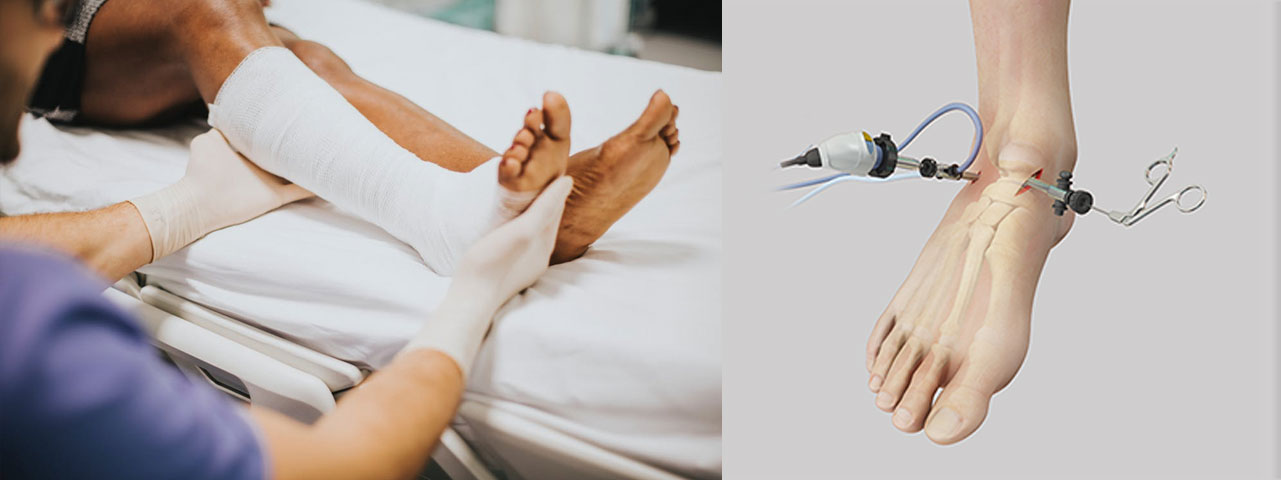Foot and Ankle Arthroscopy

Foot and ankle arthroscopy is a minimally invasive surgical procedure that employs a small camera called an arthroscope to diagnose and treat various joint conditions. With tiny incisions, the surgeon visualizes and addresses issues such as cartilage damage, ligament injuries, and impingement. This approach minimizes tissue trauma, resulting in less postoperative pain and quicker recovery compared to traditional surgery. Common treatments include removing loose bodies and repairing damaged structures. Patients undergo rehabilitation and receive postoperative care instructions, with follow-up appointments to monitor progress. Foot and ankle arthroscopy is particularly valuable for its precision in addressing joint-related problems.
Why its done
Foot and ankle arthroscopy is performed for both diagnostic and therapeutic purposes. It is conducted to diagnose the underlying causes of foot and ankle pain, stiffness, or dysfunction when traditional imaging methods may be inconclusive. Additionally, it serves as a minimally invasive surgical technique to treat various conditions, including cartilage damage, ligament injuries, and impingement. The procedure is sought to reduce postoperative pain, minimize tissue disruption, and accelerate recovery compared to traditional open surgery. Ultimately, foot and ankle arthroscopy aims to provide a precise diagnosis and targeted treatment to alleviate symptoms, restore joint function, and improve overall mobility.
Risk
While foot and ankle arthroscopy is generally considered a safe and effective procedure, it, like any surgical intervention, comes with certain risks and potential complications. Patients should be aware of these factors and discuss them thoroughly with their healthcare provider. Common risks associated with foot and ankle arthroscopy include:
- Infection: There is a risk of infection, although it is generally low. Strict sterile techniques are employed during the procedure to minimize this risk.
- Bleeding: As with any surgery, there is a potential for bleeding. However, significant bleeding is rare in arthroscopic procedures.
- Nerve or Blood Vessel Damage: The use of arthroscopic instruments carries a small risk of unintentional damage to nearby nerves or blood vessels, potentially causing numbness, tingling, or circulation issues.
- Stiffness or Weakness: Some patients may experience temporary stiffness or weakness in the foot or ankle following surgery, particularly if extensive repair or reconstruction is performed.
- Persistent Pain: In certain cases, patients may continue to experience pain after the surgery, necessitating further evaluation and management.
- Scar Tissue Formation (Arthrofibrosis): Excessive scar tissue may develop in the joint, potentially limiting range of motion and function.
- Incomplete Healing: Tissues may not heal as expected in some cases, requiring additional interventions or procedures.
- Anesthetic Risks: General or regional anesthesia carries its own set of risks, including allergic reactions, respiratory issues, or adverse reactions to anesthesia drugs.
- Failure to Resolve Symptoms: While foot and ankle arthroscopy can be successful in addressing specific issues, there is no guarantee that all symptoms will be completely resolved.
- Complications from Specific Procedures: The nature and complexity of specific arthroscopic procedures may introduce additional risks or complications, and these should be discussed with the healthcare team.
It's important for patients to disclose their complete medical history to their healthcare provider, follow pre- and postoperative instructions diligently, and attend scheduled follow-up appointments to monitor the healing process and address any concerns promptly. While the overall risk profile of foot and ankle arthroscopy is generally low, individual experiences may vary, and the specific risks can depend on factors such as the patient's overall health, the complexity of the procedure, and the surgeon's expertise.
Procedure
The procedure of foot and ankle arthroscopy involves several key steps, offering a minimally invasive approach to diagnose and treat various joint-related issues. Here is an overview of the typical foot and ankle arthroscopy procedure:
Anesthesia: Administering general or regional anesthesia for patient comfort.
Incision Placement: Creating small incisions around the affected joint for instrument access.
Arthroscopic Inspection: Inserting an arthroscope to visualize the joint on a monitor.
Diagnostic Evaluation: Examining cartilage, ligaments, tendons, and synovium for diagnosis.
Treatment or Repair: Performing arthroscopic procedures based on diagnostic findings.
Closure: Removing instruments and closing small incisions with stitches.
Recovery and Rehabilitation: Monitoring in the recovery room and initiating postoperative physical therapy.
Postoperative Care: Providing instructions for wound care, pain management, and joint movement.
Follow-up Appointments: Scheduling appointments to monitor progress and assess rehabilitation effectiveness.
